Transcript YouTube Video to Text, Practical Workflow for Creators and Learners
Turning spoken words into written content unlocks search traffic, better accessibility, and endless repurposing ideas. Whether you clip lessons from your favorite channels, publish multi-language captions for your uploads, or sift through research interviews, a clear transcript shortens every task. This guide walks through simple paths to transcribe a YouTube video to text, compares popular generators, and shows how to polish the final document until it reads like a crafted article.
Why Converting YouTube Audio into Text Matters
Video looks effortless on screen, yet hidden benefits arrive when the soundtrack appears on the page. A text layer:
- Gives hard-of-hearing viewers equal access
- Pushes keywords into Google, boosting video SEO
- Let's writers quote passages without replaying footage
- Transforms content into blogs, newsletters, ebooks, or social posts
Creators who handle transcripts early enjoy a library of searchable ideas ready for reuse. Viewers, meanwhile, can scan, bookmark, and share passages that once lived only in pixels.
Quick Start, Using the Built-In Caption Panel
YouTube creates automatic captions for most public videos. They are not perfect, but for short clips or initial drafts, the built-in transcript requires no extra apps.
Finding the automatic transcript
- Open the video, click the three dots below the player, then choose Show transcript.
- A side panel lists timestamps with the spoken words. If the menu is missing, captions may still be processing, or the channel owner disabled them.
Copying and formatting within minutes
Click the three dots inside the transcript panel, select Toggle timestamps to hide timecodes, then copy the plain text. Paste the result into a document for light editing. Swap speaker names, break long paragraphs, and remove filler words. This method keeps context close to the source, though accuracy depends on audio clarity and pronunciation.
Online Helpers When Captions Fall Short
When channel captions lag or you need extras such as multi-language export, online generators step in. Dozens of sites promise quick results; the best balance speed with strong speech recognition and neat formatting.
Skimming AI YouTube summarizer for rapid clarity
The Skimming AI fetches the full transcript with one link drop, then provides an instant overview of the main points. This dual output lets teams skim themes before diving into fine-grained editing.
Other popular free converters
- Tactiq copies captions, highlights keywords, and logs meetings along with YouTube clips.
- NoteGPT shows timestamps beside each sentence, handy for mapping show notes.
- Youtubetotranscript.com strips ads and sidebars, keeping focus on text alone.
All three accept a video URL and return straightforward text files. Results vary in punctuation, so reserve time for cleanup.
Advanced Options for Long Videos and Multiple Languages
Speech-to-text software with batch mode
Podcasters and educators who handle hours of footage weekly often move beyond browser tools. Desktop suites such as Whisper-based apps run locally, trimming upload time and avoiding privacy worries. Import a playlist, set language detection, then sip coffee while transcripts render in the background.
SRT and VTT files for caption editing
Generators that export SubRip (SRT) or WebVTT formats save steps when you later upload improved captions. Open these files in a subtitle editor, adjust timing, and push them to YouTube Studio so that viewers can toggle perfect captions on playback.
Accuracy Check, Cleanup, and Readability
Automatic captions guess punctuation and sometimes mishear terms, especially names or niche jargon. A quick manual pass lifts the text to publication standard.
Removing filler words
Search for “um,” “uh,” “you know,” and similar space fillers. Deleting them tightens sentences and sharpens meaning without altering the speaker’s voice.
Formatting dialogue for articles
Replace long streams with shorter paragraphs. Insert speaker labels when two or more voices overlap. If you plan to quote in a blog, swap second-person phrases for neutral narration so context stands alone.
Legal Tips, Fair Use, and Attribution
Before distributing someone else’s transcript, confirm usage rights. Educational clips under fair use are usually safe to quote in small portions with a link to the source, for commercial distribution, request permission, or point readers back to the original upload. When transcribing your content, mention that captions were revised for clarity so viewers know why on-screen words may differ slightly.
Bring It All Together and Share Your Finished Transcript
With a cleaned document in hand, you can now:
- Add text under the YouTube description box for SEO lift
- Convert YouTube to text and post as a blog entry to reach readers who skip video
- Create downloadable PDF study notes or ebooks
- Feed the transcript into a video transcript generator to build chapter markers
- Translate into additional languages to widen reach


